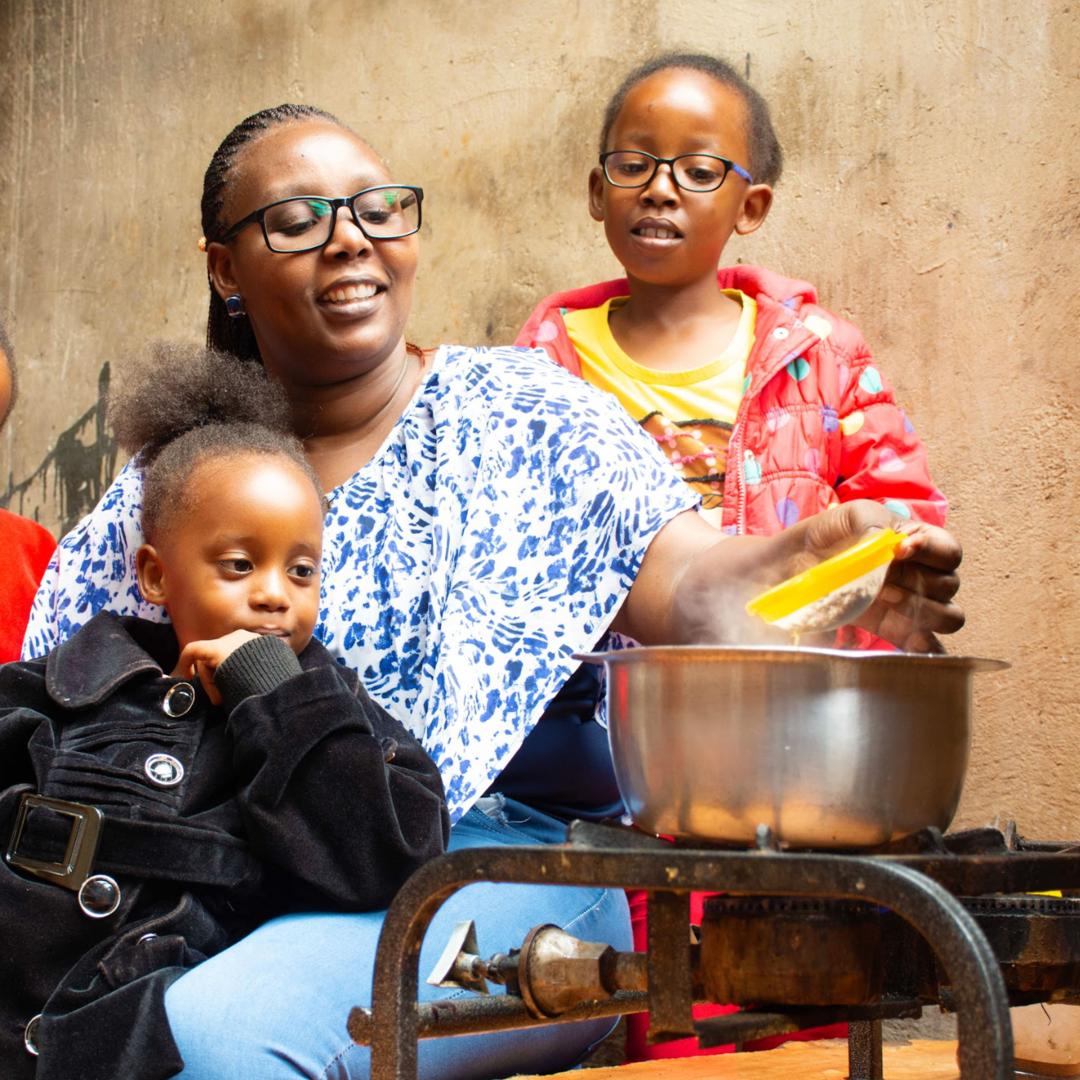References
Afrane, G., & Ntiamoah, A. (2011). Comparative life cycle assessment of charcoal, biogas, and liquefied petroleum gas as cooking fuels in Ghana. Journal of Industrial Ecology, 15(4), 539-549. https://onlinelibrary.wiley.com/doi/abs/10.1111/j.1530-9290.2011.00350.x
Afrane, G., & Ntiamoah, A. (2012). Analysis of the life-cycle costs and environmental impacts of cooking fuels used in Ghana. Applied energy, 98, 301-306. https://www.sciencedirect.com/science/article/abs/pii/S0306261912002590
Anenberg, S. C., Balakrishnan, K., Jetter, J., Masera, O., Mehta, S., Moss, J., & Ramanathan, V. (2013). Cleaner cooking solutions to achieve health, climate, and economic cobenefits. https://pubs.acs.org/doi/10.1021/es304942e
Bailis, R., Drigo, R., Ghilardi, A., & Masera, O. (2015). The carbon footprint of traditional woodfuels. Nature Climate Change, 5(3), 266-272. https://www.nature.com/articles/nclimate2491
Bensch, G., Jeuland, M., & Peters, J. (2021). Efficient biomass cooking in Africa for climate change mitigation and development. One Earth, 4(6), 879-890. https://www.cell.com/one-earth/pdf/S2590-3322(21)00296-7.pdf
Bennitt, F. B., Wozniak, S. S., Causey, K., Burkart, K., & Brauer, M. (2021). Estimating disease burden attributable to household air pollution: new methods within the Global Burden of Disease Study. The Lancet Global Health, 9, S18. https://doi.org/10.1016/S2214-109X(21)00126-1
Bergero, C., Gosnell, G., Gielen, D., Kang, S., Bazilian, M., & Davis, S. J. (2023). Pathways to net-zero emissions from aviation. Nature Sustainability, 6(4), 404-414. https://www.nature.com/articles/s41893-022-01046-9
Biswas, S., & Das, U. (2022). Adding fuel to human capital: Exploring the educational effects of cooking fuel choice from rural India. Energy Economics, 105, 105744. https://doi.org/10.1016/j.eneco.2021.105744
Cabiyo, B., Ray, I., & Levine, D. I. (2020). The refill gap: clean cooking fuel adoption in rural India. Environmental Research Letters, 16(1), 014035. https://iopscience.iop.org/article/10.1088/1748-9326/abd133
Cashman, S., Rodgers, M., & Huff, M. (2016). Life-cycle assessment of cookstove fuels in India and China. US Environmental Protection Agency, Washington, DC. EPA/600/R-15/325. https://cleancooking.org/wp-content/uploads/2021/07/496-1.pdf
Clean Cooking Alliance (CCA). (2023). Accelerating clean cooking as a nature-based solution. https://cleancooking.org/reports-and-tools/accelerating-clean-cooking-as-a-nature-based-climate-solution/
Clean Cooking Alliance. (2022). Clean cooking as a catalyst for sustainable food systems. https://cleancooking.org/wp-content/uploads/2023/11/CCA_Clean-Cooking-as-a-Catalyst-for-Sustainable-Food-Systems.pdf
Climate & Clean Air Coalition (2024). Nationally determined contributions and clean cooking. https://www.ccacoalition.org/resources/nationally-determined-contributions-and-clean-cooking
Choudhuri, P., & Desai, S. (2021). Lack of access to clean fuel and piped water and children’s educational outcomes in rural India. World Development, 145, 105535. https://doi.org/10.1016/j.worlddev.2021.105535
Dagnachew, A. G., Lucas, P. L., van Vuuren, D. P., & Hof, A. F. (2018). Towards universal access to clean cooking solutions in sub-Saharan Africa. PBL Netherlands Environmental Assessment Agency.
Energy Sector Management Assistance Program. (2023). Building evidence to unlock impact finance : A field assessment of lean cooking co-benefits for climate, health, and gender. Retrieved 13 September 2024, from https://www.esmap.org/Building_Evidence_To_unloc_Impact_Finance_Benefits
Fullerton, D. G., Bruce, N., & Gordon, S. B. (2008). Indoor air pollution from biomass fuel smoke is a major health concern in the developing world. Transactions of the Royal Society of Tropical Medicine and Hygiene, 102(9), 843–851. https://doi.org/10.1016/j.trstmh.2008.05.028
Down to Earth (2022). Ujjwala: Over 9 million beneficiaries did not refill cylinder last year, Centre admits. Retrieved 20 June 2024, from https://www.downtoearth.org.in/energy/ujjwala-over-9-million-beneficiaries-did-not-refill-cylinder-last-year-centre-admits-84130
Garland, C., Delapena, S., Prasad, R., L'Orange, C., Alexander, D., & Johnson, M. (2017). Black carbon cookstove emissions: A field assessment of 19 stove/fuel combinations. Atmospheric Environment, 169, 140-149. https://doi.org/10.1016/j.atmosenv.2017.08.040
International Energy Agency (2022). Africa energy outlook. https://www.iea.org/reports/africa-energy-outlook-2022/key-findings
International Energy Agency (2023a). A vision for clean cooking access for all. https://iea.blob.core.windows.net/assets/f63eebbc-a3df-4542-b2fb-364dd66a2199/AVisionforCleanCookingAccessforAll.pdf
International Energy Agency (2023b). Electricity market report. https://www.iea.org/reports/electricity-market-report-update-2023
Intergovernmental Panel on Climate Change (2022). Climate change 2022: mitigation of climate change. Contribution of the Working Group III to the sixth assessment report of the Intergovernmental Panel on Climate Change. https://www.ipcc.ch/report/ar6/wg3/
Jameel, Y., Patrone, C. M., Patterson, K. P., & West, P. C. (2022). Climate-poverty connections: Opportunities for synergistic solutions at the intersection of planetary and human well-being. https://drawdown.org/publications/climate-poverty-connections-report
Jewitt, S., Atagher, P., & Clifford, M. (2020). “We cannot stop cooking”: Stove stacking, seasonality and the risky practices of household cookstove transitions in Nigeria. Energy Research & Social Science, 61, 101340. https://www.sciencedirect.com/science/article/pii/S2214629619304700?via%3Dihub
Johnson, E. (2009). Charcoal versus LPG grilling: a carbon-footprint comparison. Environmental Impact Assessment Review, 29(6), 370-378. https://www.sciencedirect.com/science/article/abs/pii/S0195925509000420
Kapsalyamova, Z., Mishra, R., Kerimray, A., Karymshakov, K., & Azhgaliyeva, D. (2021). Why energy access is not enough for choosing clean cooking fuels? Evidence from the multinomial logit model. Journal of Environmental Management, 290, 112539. https://www.sciencedirect.com/science/article/pii/S0301479721006010
Khavari, B., Ramirez, C., Jeuland, M., & Fuso Nerini, F. (2023). A geospatial approach to understanding clean cooking challenges in sub-Saharan Africa. Nature Sustainability, 6(4), 447-457 https://www.nature.com/articles/s41893-022-01039-8
Lacey, F. G., Henze, D. K., Lee, C. J., van Donkelaar, A., & Martin, R. V. (2017). Transient climate and ambient health impacts due to national solid fuel cookstove emissions. Proceedings of the National Academy of Sciences, 114(6), 1269-1274.https://www.pnas.org/doi/full/10.1073/pnas.1612430114
Lansche, J., & Müller, J. (2017). Life cycle assessment (LCA) of biogas versus dung combustion household cooking systems in developing countries–a case study in Ethiopia. Journal of cleaner production, 165, 828-835. https://www.sciencedirect.com/science/article/abs/pii/S0959652617315597
Lee, M., Chang, J., Deng, Q., Hu, P., Bixby, H., Harper, S., ... & Liu, J. (2024). Effects of a coal to clean heating policy on acute myocardial infarction in Beijing: a difference-in-differences analysis. The Lancet Planetary Health, 8(11), e924-e932. https://doi.org/10.1016/S2542-5196(24)00243-2
Mazorra, J., Sánchez-Jacob, E., de la Sota, C., Fernández, L., & Lumbreras, J. (2020). A comprehensive analysis of cooking solutions co-benefits at household level: Healthy lives and well-being, gender and climate change. Science of The Total Environment, 707, 135968. https://www.sciencedirect.com/science/article/abs/pii/S0048969719359637
Po, J. Y. T., FitzGerald, J. M., & Carlsten, C. (2011). Respiratory disease associated with solid biomass fuel exposure in rural women and children: Systematic review and meta-analysis. Thorax, 66(3), 232–239. https://doi.org/10.1136/thx.2010.147884
Rosenthal, J., Quinn, A., Grieshop, A. P., Pillarisetti, A., & Glass, R. I. (2018). Clean cooking and the SDGs: Integrated analytical approaches to guide energy interventions for health and environment goals. Energy for Sustainable Development, 42, 152-159. https://www.sciencedirect.com/science/article/pii/S0973082617309857
Shaik, S. R., Muthukumar, P., & Kalita, P. C. (2022). Life cycle assessment of LPG cook-stove with porous radiant burner and conventional burner–a comparative study. Sustainable Energy Technologies and Assessments, 52, 102255. https://doi.org/10.1016/j.seta.2022.102255
Shankar, A. V., Quinn, A. K., Dickinson, K. L., Williams, K. N., Masera, O., Charron, D., ... & Rosenthal, J. P. (2020). Everybody stacks: Lessons from household energy case studies to inform design principles for clean energy transitions. Energy Policy, 141, 111468. https://doi.org/10.1016/j.enpol.2020.111468
Simkovich, S. M., Williams, K. N., Pollard, S., Dowdy, D., Sinharoy, S., Clasen, T. F., ... & Checkley, W. (2019). A systematic review to evaluate the association between clean cooking technologies and time use in low-and middle-income countries. International journal of environmental research and public health, 16(13), 2277. https://www.mdpi.com/1660-4601/16/13/2277
Singh, P., Gundimeda, H., & Stucki, M. (2014). Environmental footprint of cooking fuels: a life cycle assessment of ten fuel sources used in Indian households. The International Journal of Life Cycle Assessment, 19, 1036-1048. https://link.springer.com/article/10.1007/s11367-014-0699-0
Smith, K. R. (2002). In praise of petroleum? Science, 298(5600), 1847-1847. DOI: 10.1126/science.298.5600.1847
Stoner, O., Lewis, J., Martínez, I. L., Gumy, S., Economou, T., & Adair-Rohani, H. (2021). Household cooking fuel estimates at global and country level for 1990 to 2030. Nature communications, 12(1), 5793.https://www.nature.com/articles/s41467-021-26036-x
U.S. Environmental Protection Agency. (2022). 2021-2022 residential induction cooking tops. Retrieved 19 August 2024, from https://www.energystar.gov/partner_resources/products_partner_resources/brand-owner/eta-consumers/res-induction-cooking-tops#:~:text=Residential%20induction%20cooking%20tops%20instead,energy%20with%20approximately%2085%25%20efficiency.
World Bank (2018). A recipe for protecting the Democratic Republic of Congo’s tropical forests. Retrieved 16 January 2025, from https://www.worldbank.org/en/news/feature/2018/01/24/a-recipe-for-protecting-the-democratic-republic-of-congos-tropical-forests
World Bank (2020). Energy Sector Management Assistance Program. (2020). The state of access to modern energy cooking services. https://www.worldbank.org/en/topic/energy/publication/the-state-of-access-to-modern-energy-cooking-services
World Bank (2023). Moving the needle on clean cooking for all. Retrieved 13 September 2024, from https://www.worldbank.org/en/results/2023/01/19/moving-the-needle-on-clean-cooking-for-all
World Health Organization (2025). Proportion of population with primary reliance on clean fuels and technologies. Retrieved 1, May 2025, from https://www.who.int/data/gho/data/themes/air-pollution/household-air-pollution
World Health Organization (2023). Achieving universal access and net-zero emissions by 2050: a global roadmap for just and inclusive clean cooking transition. https://www.who.int/publications/m/item/achieving-universal-access-by-2030-and-net-zero-emissions-by-2050-a-global-roadmap-for-just-and-inclusive-clean-cooking-transition
World Health Organization (2024a). WHO publishes new global data on the use of clean and polluting fuels for cooking by fuel type. Retrieved 17 June 2024, https://www.who.int/news/item/20-01-2022-who-publishes-new-global-data-on-the-use-of-clean-and-polluting-fuels-for-cooking-by-fuel-type#:~:text=As%20of%202021%2C%202.3%20billion,%2D%20and%20middle%2Dincome%20countries.
World Health Organization (2024b). Household air pollution. Retrieved 17 June 2024, https://www.who.int/news-room/fact-sheets/detail/household-air-pollution-and-health

